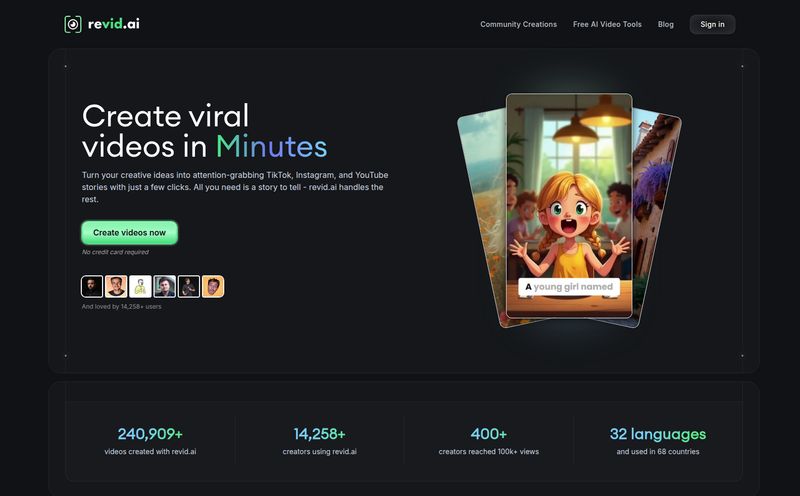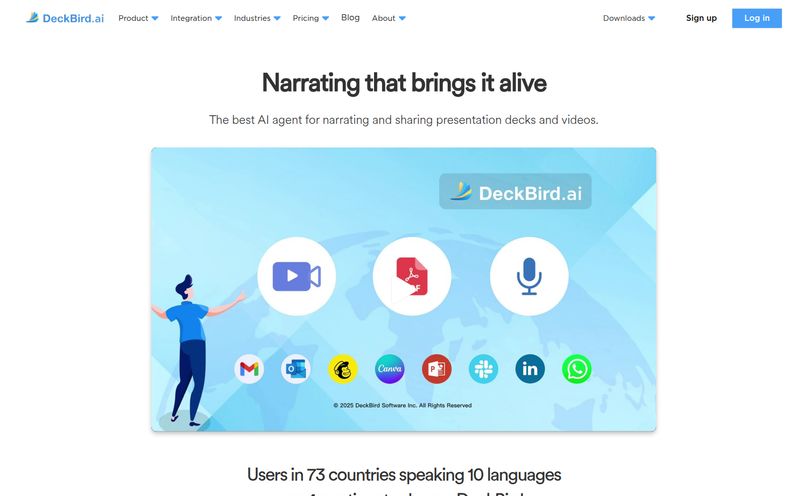I’ve been in the digital marketing and SEO game for what feels like a lifetime. I’ve seen trends come and go. I remember the frantic scramble for keyword density, the pivot to long-form content, the rise of voice search, and the endless, endless content hamster wheel. We're always looking for that next edge, right? That new tool that’ll make our lives easier and our content pop.
Lately, the buzz has been deafening around AI video generation. We've all seen the mind-blowing clips from OpenAI's Sora, making us question reality itself. But for most of us on the ground—the bloggers, the social media managers, the small business owners—tools like that feel a million miles away. They're the shiny concept cars of the AI world. Cool to look at, but you can't exactly drive one off the lot.
And that’s why I got so interested in Stable Video Diffusion (SVD). It’s a different beast entirely. It’s not trying to be a Hollywood blockbuster generator. It’s more like the people’s AI video tool. And honestly? I think it’s one of the most exciting things to happen to content creation in a while.
So, What Exactly Is Stable Video Diffusion?
Let's break it down without the jargon. At its heart, Stable Video Diffusion is an AI model from the folks at Stability AI (you know, the creators of the hugely popular Stable Diffusion image generator). It takes a single, static image and breathes life into it, turning it into a short video clip. It can also generate video from a text prompt, but its real magic, in my opinion, lies in animating existing images.
Think about that for a second. Every static graphic, every product photo, every illustration you’ve ever commissioned now has the potential to move. That still image of a coffee cup can suddenly have steam rising from it. A landscape photo can have clouds drifting across the sky. It's like giving your content library a shot of adrenaline.

Visit Stable Video Diffusion
A Quick Peek Under the Hood
You don't need to be a machine learning engineer to use SVD, thank goodness. But as an SEO, I love knowing a little about the 'how'. The process is pretty clever. The model is built on a foundation of a massive library of images, so it first understands what things are (this is the 'Image Pre-training'). Then, it's trained on a huge dataset of videos to learn the principles of motion (that's the 'Video Pre-training').
It's like teaching a kid. First, you show them a picture of a car. Then you show them a video of a car driving. Eventually, they can see a new picture of a car and imagine how it might move. SVD does the same thing, just on a ridiculously massive scale. The final step is fine-tuning it for high-quality output, which is what separates a blurry mess from a clean, captivating clip.
The Good, The Bad, and The… Beautifully Chaotic
Alright, let's get real. No tool is perfect. SVD is a powerful new paintbrush, but it's not a point-and-shoot camera. It has its own personality, with incredible strengths and some… let’s call them quirks.
What I Absolutely Love
The biggest win here is its accessibility. Because SVD is open-source, the code is out there for anyone to see, use, and build upon. This is huge! It means we have platforms (like the one shown in the images) offering free access. For a marketer on a budget, free is a very, very good price. It democratizes the technology, taking it out of the exclusive hands of a few tech giants. I've also found its ability to create multi-view 3D-like video from a single image to be surprisingly effective for making product shots feel more tangible and dynamic.
The Charming Imperfections
Now for the other side of the coin. The biggest limitation right now is video length. SVD is optimized for short bursts—we're talking about 4 seconds, tops. You're not going to be making your next webinar with this. It's for creating digital eye-candy, not long-form narratives.
The other major point is control. Or the lack thereof. There is a high degree of randomness to the output. You can give it an image of a serene lake and ask it to animate, and you might get gentle ripples. Or you might get a kraken. Okay, probably not a kraken, but the motion can be unpredictable. I once spent an hour trying to get a subtle pan on a cityscape and ended up with a wobbly, almost psychedelic zoom. It’s less like directing a film and more like rolling a set of creative dice. Sometimes you get what you want, and sometimes you get a happy accident that's even better. The potential is just to big to ignore.
How Can We Actually Use This for SEO and Marketing?
This is where my brain really starts buzzing. The unpredictability isn't always a bug; sometimes it's a feature.
- Social Media on Steroids: Think of all the static quote cards and announcements you post. Imagine if they had subtle animations. A little shimmer, a slow zoom. It's enough to stop the scroll and boost engagement, which we all know the algorithms love.
- Living Product Photos: If you run an e-commerce site, this is a goldmine. Animate a product photo to give it a 360-degree feel. Make the fabric on a piece of clothing ripple. It adds a layer of professionalism and interactivity that can seriously improve conversion rates.
- Endless B-Roll: Need some abstract background video for a YouTube video or a website banner? Give SVD an interesting texture or a cool graphic and see what it spits out. You can generate a dozen unique B-roll clips in the time it would take to find one good piece of stock footage.
SVD vs. The Titans like Sora and RunwayML
It’s tempting to compare SVD directly to the big dogs like OpenAI's Sora or RunwayML, but I don’t think that’s the right way to look at it. Sora is aiming for jaw-dropping, photorealistic cinema. It’s incredible, but it’s also a closed, mysterious black box.
Stable Video Diffusion is the punk rock alternative. It’s raw, it's accessible, it's a little bit messy, and it’s for everyone. It’s not about replacing Hollywood cinematographers; it's about empowering the everyday creator to make their static content more dynamic and engaging without needing a Ph.D. or a venture capital budget.
Let's Talk Money: The Best Price is Free
This is a short section. Because Stable Video Diffusion is an open-source model, you can often use it for free on various online platforms. The catch? You might face queues, or have limits on daily use. The alternative for the more tech-savvy is to download the model from a place like GitHub and run it on your own powerful computer. This gives you unlimited freedom but requires some technical know-how and a beefy graphics card. For most people, the free online versions will be more than enough to get started.
Frequently Asked Questions About SVD
Is Stable Video Diffusion really free to use?
Mostly, yes. The underlying model is open-source. Many web platforms let you use it for free, sometimes with limitations. If you have the technical skills and hardware, you can run it yourself at no cost beyond your electricity bill.
How long can the videos be?
This is its main limitation right now. The models are trained to generate short clips, typically around 2-4 seconds long. Perfect for social media, not for your next feature film.
Is it difficult for a non-techie to use?
Not at all! The web interfaces are designed to be user-friendly. You basically upload an image, maybe tweak a setting or two like 'motion intensity', and click 'generate'. The hardest part is having the patience to experiment.
What's the difference between this and Stable Diffusion for images?
Think of them as siblings. Stable Diffusion creates a still image from a text prompt. Stable Video Diffusion takes a still image (or text) and adds the dimension of time to it, creating a moving sequence.
Can I use the videos for my business?
Generally, yes, but always check the license. The model was released under a non-commercial, research-focused license initially. However, many platforms that host the tool have their own terms of service. Always do your due diligence before using generated content in a major commercial project.
Where is this technology headed?
Longer videos, more control, and higher resolution. The pace of development in this space is staggering. What is a 4-second limitation today might be a 30-second capability in six months. The future is bright and full of motion.
My Final Thoughts: A Motion-Filled Future
Stable Video Diffusion isn't perfect. It's a bit of a wild card. It can be unpredictable. But it’s also a blast to play with and holds incredible potential for anyone making content online. It represents a major step in making AI-powered creation tools available to everyone, not just a select few.
My advice? Don't wait for it to be perfect. Jump in now. Play with it. See what weird, wonderful things you can create. Animate your logo, bring a blog post's header image to life, or just feed it a random photo and see what happens. You might be surprised at the magic you can make with just a single image and a little bit of AI-powered chaos.
Reference and Sources
- Stability AI Official Announcement
- Stable Video Diffusion on GitHub
- OpenAI Sora Project Page
- RunwayML Homepage



